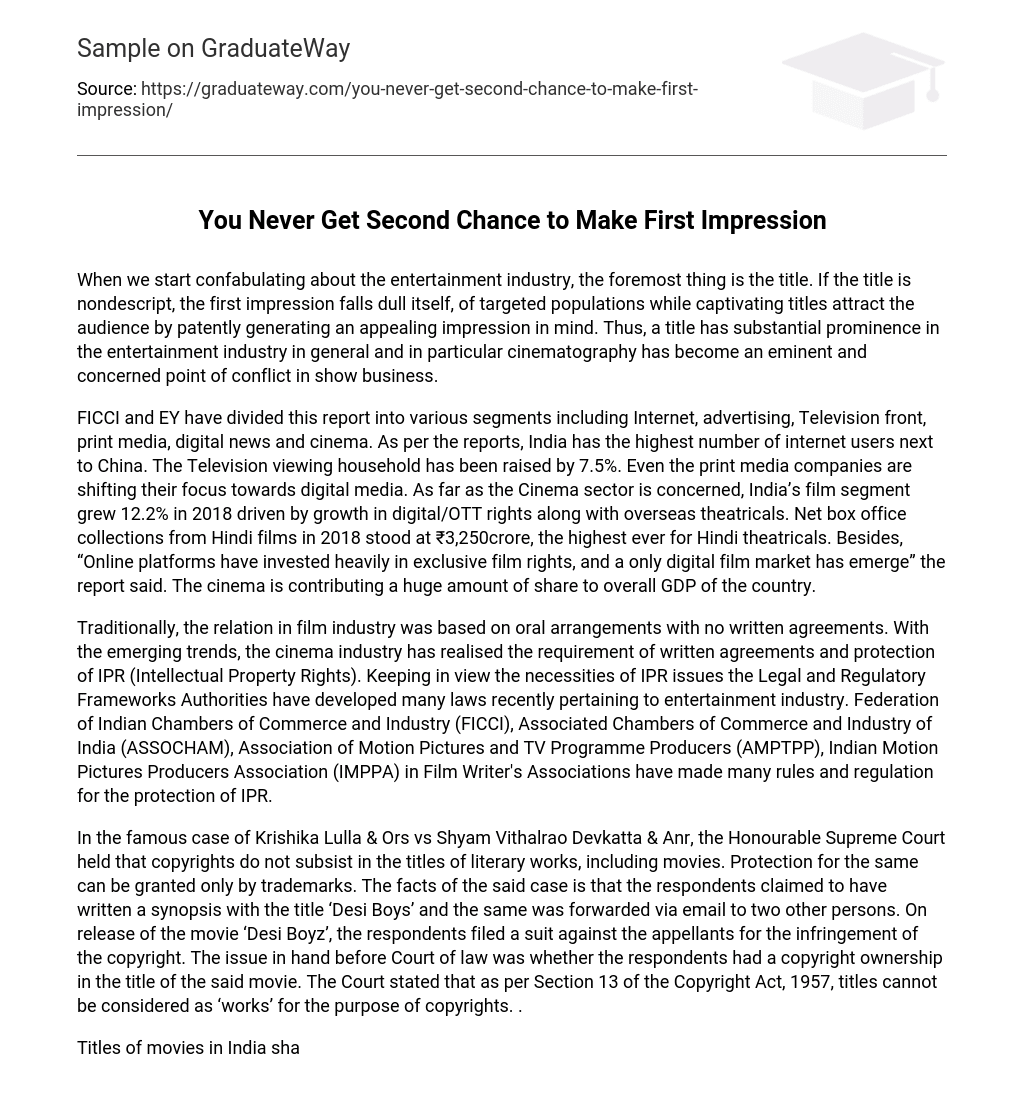When we start confabulating about the entertainment industry, the foremost thing is the title. If the title is nondescript, the first impression falls dull itself, of targeted populations while captivating titles attract the audience by patently generating an appealing impression in mind. Thus, a title has substantial prominence in the entertainment industry in general and in particular cinematography has become an eminent and concerned point of conflict in show business.
FICCI and EY have divided this report into various segments including Internet, advertising, Television front, print media, digital news and cinema. As per the reports, India has the highest number of internet users next to China. The Television viewing household has been raised by 7.5%.
Even the print media companies are shifting their focus towards digital media. As far as the Cinema sector is concerned, India’s film segment grew 12.2% in 2018 driven by growth in digital/OTT rights along with overseas theatricals. Net box office collections from Hindi films in 2018 stood at 3,250crore, the highest ever for Hindi theatricals. Besides, “Online platforms have invested heavily in exclusive film rights, and a only digital film market has emerge” the report said. The cinema is contributing a huge amount of share to overall GDP of the country.
Traditionally, the relation in film industry was based on oral arrangements with no written agreements. With the emerging trends, the cinema industry has realised the requirement of written agreements and protection of IPR (Intellectual Property Rights). Keeping in view the necessities of IPR issues the Legal and Regulatory Frameworks Authorities have developed many laws recently pertaining to entertainment industry. Federation of Indian Chambers of Commerce and Industry (FICCI), Associated Chambers of Commerce and Industry of India (ASSOCHAM), Association of Motion Pictures and TV Programme Producers (AMPTPP), Indian Motion Pictures Producers Association (IMPPA) in Film Writer’s Associations have made many rules and regulation for the protection of IPR.
In the famous case of Krishika Lulla & Ors vs Shyam Vithalrao Devkatta & Anr, the Honourable Supreme Court held that copyrights do not subsist in the titles of literary works, including movies. Protection for the same can be granted only by trademarks. The facts of the said case is that the respondents claimed to have written a synopsis with the title ‘Desi Boys’ and the same was forwarded via email to two other persons.
On release of the movie ‘Desi Boyz’, the respondents filed a suit against the appellants for the infringement of the copyright. The issue in hand before Court of law was whether the respondents had a copyright ownership in the title of the said movie. The Court stated that as per Section 13 of the Copyright Act, 1957, titles cannot be considered as ‘works’ for the purpose of copyrights. .
Titles of movies in India shall be registered under Class 41 of NICE classification of trademarks Act, 1999. Film titles can be further divided into two heads, i.e. titles of series of movies, like for instance ‘Housefull 2’ and ‘Housefull 3’ and the title of single movie. In the latter case, it is necessary to establish that the title has been acquired secondary meaning amongst the mass at large. The Nice Classification (NCL), established by the Nice Agreement (1957), is an international classification of goods and services applied for the registration of marks.
There are many judgments on trademark protection. The famous ones are as follows: In this case Sholay Media And Entertainment vs Parag Sanghavi And Ors, G.P.Sippy produced a blockbuster film named ‘Sholay’ in 1975 and got the film name and its characters name registered under Trade Mark Act, 1999. Another famous producer produced the film named ‘Ram Gopal Verma ke Sholay’ and used the names of original characters from ‘Sholay’. In 2007, Sascha Sippy (grandson of G.P.Sippy), filed a suit against Ram Gopal Verma and taking the benefit of registration under the act he succeeded the case.
Conclusion
The role of Film industry has increased rapidly in the country’s GDP from past few years. The protection of cinematography is very essential not only under Intellectual Property right but also in other streams of law. The legislation has given importance to cinematography under IPR as well as in tax laws.
The legal and regulatory reforms have been established which will help entertainment industry in their protection and its regulation. As we have discussed the laws which govern cinematography under IPR i.e. Copyright Act, Trade mark Act. The scope of copyright act is very wide, so it provides the honour and virtue to the unique idea.
Basically, neither copyright nor trademark protects the titles of films but copyright protects ingenuity of the innovation and provides ‘authorship’, on the other hand trademark gives it ‘uniqueness’. Therefore, registration provides a protection to title by making it distinguishable from others.





